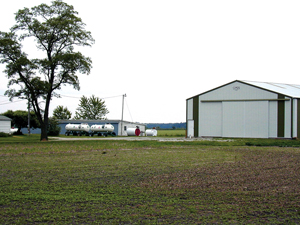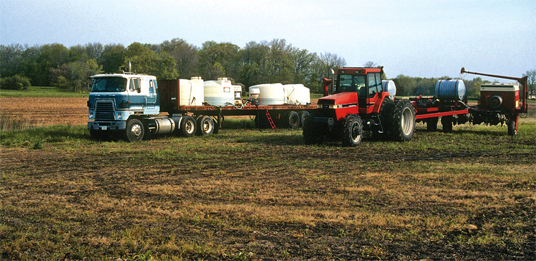There are various approaches that you can take to protect people, property, and other assets; and whether you ultimately choose a high-tech electronic system or just locks and lights, you must plan your approach and adopt the procedures necessary to implement it. Study your situation and identify any assets that might be threatened, establish the measures that you feel are adequate to protect those assets (such as installing equipment), and implement your system by training and assigning personnel to manage it. Your strategy and security design should be commensurate with perceived security risks and the assets to be protected.

Physical Protection Planning
-
Arrange to have a security survey conducted.
- Your insurance agent probably performed a limited assessment of your property to identify risks on which to base premiums. But since insurance appraisals are generally targeted toward fire and safety, they often yield insufficient information on which to base a comprehensive physical protection program.
- State and local law enforcement agencies are efficient in conducting surveys to identify vulnerable property and assets.
- A risk survey conducted by your fire department can identify fire risks and yield information that is helpful in making your facility safer. Example: An 80-foot setback is recommended for aboveground fuel tanks (heating oil tanks excluded).
- A comprehensive survey conducted by an independent professional consultant is essential if you plan to purchase security equipment. Request a physical protection evaluation and a site characterization of your property and assets, and ask the consultant to design a physical protection system based on your risk potential.

- Ask your local Cooperative Extension Service educator for information on accessing security professionals and programs that deal with farm security.
- Bookmark the USDA website for the Animal and Plant Health Inspection Service. This website has color photographs and information on diseases that USDA believes terrorists/extremists could use to threaten U.S. agriculture. The quick recognition of these foreign diseases by farmers and the agricultural industry is critical in preventing their spread and limiting their impact.
- The EDEN website provides valuable links to state contacts on homeland security issues.
- Review the FBI advisory dealing with the receipt of suspicious letters or packages on the farm. The advisory information can be downloaded from the following website:
http://www.fbi.gov/pressre1/pressre101/mail3.pdf. - Ask groups such as the Cooperative Extension Service and commodity associations to arrange a series of meetings to discuss what would happen to you, your family, and your crops and livestock if your farm or county were quarantined.
- Ask insurance agents what coverage is available for lost income and increased expenses due to quarantine; and ask government officials if you would qualify for subsidies in the event of loss due to quarantine.
- Ask government officials (e.g., USDA Farm Service Agency personnel) how they would compute your financial losses resulting from crop or animal quarantine.
- Estimate what you think the loss would be if your crops and livestock were subject to a government quarantine or product recall.
- Make sure critical items are covered by your farm insurance.
- Be familiar with your state's hazard response plan for animal and plant emergencies.
- Videotape insured assets, including physical protection measures, to support insurance claims. Still photos with dates, identifiable backgrounds, and lists of serial numbers and model numbers are also very helpful. Store copies of these and all emergency information off-site in case your farm office is destroyed.
- Develop contingency plans in case you can't sell grain to local elevators and animals through sale barns and livestock auctions due to a quarantine in surrounding communities.
Protecting Information and Counter-Intelligence Measures
- Contact law enforcement authorities if you observe suspicious or criminal activity on or near your property. Inform your neighbors as well.
- Protect sensitive business information. Disseminate protected information on a need-to-know basis only. Keep backup copies of supporting documents off-site.
- Do not put your name on the mailbox. Criminals and other adversaries have been known to look up a number and call to see if anyone answers; and, if no one does, they burglarize or vandalize your home and steal or damage your farm vehicles and equipment. Postal authorities may ask you to display your name on the inside of your mailbox to help substitute drivers, but you have the right to refuse their request due to security concerns.
- Stop deliveries or have a trusted neighbor pick up your mail and newspapers when you are away. A mailbox full of mail and a bulging newspaper box are indications that the farm is unattended.
- Place some lights and televisions on timers.
- Inform local law enforcement agencies when you will be away for an extended time and ask them to include your farm in their routine patrols; be sure to notify them when you return, lest you be mistaken for an intruder on your own property. Notify a trusted neighbor of a planned extended absence, and leave a phone number and an address where you can be contacted.
- Join or organize a community surveillance program. Set up a meeting with your neighbors to coordinate a system for looking out for each other. Provide a list of names and telephone numbers (landline and cellular) to each group member for reporting any suspicious activity observed on your property.
- Do not discuss or advertise what you grow, especially if you are raising potentially targeted commodities such as bioengineered or genetically altered crops or livestock. This is important because activists cannot distinguish genetically modified plants and animals from their "natural" counterparts (e.g., corn or beans in a field, animals in a pen).
- Clearly and legally establish who will be responsible for the crops and livestock that you grow for alternative purposes (e.g., pharmaceuticals), once they leave the farm.
- Do not buy chemicals, fertilizers, equipment, or livestock at reduced prices from people you don't know. The merchandize could be stolen or contaminated.
Physical Protection Procedures
- Inventory critical farm assets. Conduct an inventory of important assets, including buildings, vehicles, machinery, computers, supplies, raw materials, livestock, crops, etc., and consider their vulnerability to extremists and terrorists. Compile a list, starting with the asset most likely to be targeted by intruders. While all assets deserve some level of protection, the priority process will help you focus on those that you cannot afford to lose. For example, your insurance company might not reimburse you for loss of livestock due to a power outage in a confinement building if your back-up generator is lost or stolen; so it makes good business sense to make sure the generator is in place and in good working order at all times. Review your inventory regularly.
- For valuable items without serial numbers-or with numbers that are easily defaced-add an identifying mark of your own in a discrete location. Photograph the mark, showing its exact location, and give it to your insurance carrier; keep duplicate copies with your own records.
- You or a designated, responsible employee should always be present when deliveries are made to your farm. Schedule deliveries to facilitate this procedure. Ask dealers and delivery companies to be consistent in sending the same one or two delivery persons to your farm if at all possible; if they cannot accommodate your request, ask them to maintain records of every delivery and the personnel involved.
- In coordination with emergency responders, develop and participate in realistic security training exercises. Develop and enact exercises that test the ability of your physical protection system to deter, detect, and delay a simulated intrusion (top left).
- Post "No Trespassing" signs along property lines and maintain them perpetually. Too often, signs are posted and forgotten: they deteriorate, fall down, or get removed or knocked down by vandals. So, in addition to posting signs in the first place, follow through by maintaining them.
- Signs announcing the presence of alarms, detectors, or surveillance devices can be helpful in deterring crimes.
- Vandals sometimes open valves on pesticide or fuel tanks, creating environmental hazards, so form a dike around them. Also, strategically place extra soil near ditches or creeks where it can be pushed into place to form a temporary dam downstream if a spill occurs.
- Always ask to see the credentials of anyone claiming they are doing an official government inspection. If they are for real, they won't mind your request; but if they are imposters, your merely asking the question may be enough to discourage them. Ask to see photo identification. If you doubt the validity of the person's credentials, call the office or organization that the he is representing. Do not use the telephone number provided by the inspector since he may supply a false number; and if the inspector is an imposter, it follows that the party who would answer the phone would be an imposter as well. Use your own resources, independent of the person's helpful comments and/or telephone numbers, to verify his identity and purpose. Likewise, do not assume that a vehicle bearing "official markings" is an official vehicle: check it out.
- Control all access to your farm computers to protect confidential information such as farm history and financial records. Have anti-virus software installed and updated regularly, and change your password often. Install software (generally termed "fire wall") to protect against computer hackers.
- Farm computers with full access to the Internet (not dial-up) must also have fire wall protection.
- If your computer accesses the Internet via a continuously available communications path such as cable or a digital subscriber line, shut off your computer when it is not in use to prevent unauthorized access.
- Back up your computers each evening, and consider hiring an off-site storage firm to back up your system on a regular basis. Lock your computer room each time you exit. Discourage family members and others from accessing the Internet on a computer that contains critical business data.
- Store important papers in locked, fireproof cabinets-but remember that fire-insulated cabinets designed to store paper records do not provide protection for computer discs. Paper records can withstand temperatures to 350°F, whereas computer media can be severely damaged by temperatures exceeding 125°F. Many manufacturers make small file boxes that fit into larger cabinets (right) to provide extra fire protection for computer files.
- Conduct background checks on all employees, including seasonal workers.
- Require regular vendors to conduct background checks on their drivers.
- Establish a check-in point for all farm deliveries.
- Designate a vehicle parking area and an access area for outside contractors. For example, if there is not an operational need to drive a vehicle into the barn or other areas of the farm, simply do not allow it.
-
Establish checklist procedures to ensure that access and authorization are terminated for employees who leave your employment.
- Remove the names of former employees from all internal and external lists, especially those that list personnel allowed to pick up merchandise, sign for deliveries, place/cancel/redirect orders, etc. If you fail to remove former employees from your vendor list, they can run up quite a tab and you will be responsible for the charges.
- Collect keys, credit cards, identification cards, and other means of access to your assets. Change your Personal Identification Numbers (PINs) as necessary.
- Change passwords or codes on alarm systems, etc.
- Change locks that protect critical assets in case the keys were duplicated before being returned (even if they are marked "Do Not Duplicate").
- If an employee is fired or quits without notice, notify the employee in writing, via U.S. mail, that he is not to enter your property without your prior authorization nor without an appointment.
- Move equipment into a locked building at night or when not in use; the time it takes minimal.
- Disable larger pieces of equipment by taking off critical pieces; e.g., remove anhydrous transfer hoses from nurse tanks.
- Don't leave accessible any equipment that adversaries could use to accomplish their mission: a forklift, a front-end loader, a crane, wenches, etc.
- Do not leave pesticides and farm equipment unattended along roads and highways.
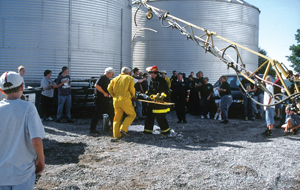
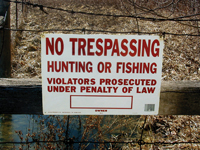

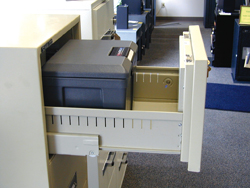
Lock and Key Control Problem
 Most farms depend on lock and key systems for access control, but the effectiveness of locks is dependent upon key control. Without effective key control, locks are useless.
Most farms depend on lock and key systems for access control, but the effectiveness of locks is dependent upon key control. Without effective key control, locks are useless.
- Establish a record of all locks and keys. State the location of each lock and the total number of keys that exist for it; also list the name of the person who is in possession of each key.
- Require employees to sign for keys, and inventory all keys periodically to account for each and every one.
- Keep key control records and spare keys locked in a safe or another secure location. Only the "key control manager" should issue and have access to key control records and spare keys.
- DO NOT HIDE KEYS! Intruders know to look under rocks, over doors, beneath doormats, etc.
- Issue keys to employees only as needed, and follow through to verify that each key is returned precisely when it should be. Remember: Locks are used to protect your assets, and keys should not be issued merely for the convenience of employees.
- Avoid or limit the use of master keys, and never take them off-site; keep keys to critical assets on-site at all times as well. The loss of a master key requires the re-keying of all locks in the system in order to restore security. Even temporary misplacement is of concern because there is no way to know for sure who might have had access to the key while it was missing, or if it has been duplicated. Keys should be returned at the end of each workday to the person in charge of your key depository.
- Many keys can be duplicated at hardware stores and discount centers, so use high-security locks for which the lock manufacturer controls the key blanks-that is, they are not distributed to hardwares and other outlets-and for which the owner is required to personally authorize duplication. High-security locks are pick-resistant, and the keys are embossed by the manufacturer with the words, "Do Not Duplicate."
- Valuable items should be secured with a lock with a built-in, programmable keypad (top right). Codes can be changed easily at a moment's notice.
- High security padlocks should have case-hardened steel shanks, and they should be tamper-resistant.
- Locks are only as good as the hasps to which they are attached. Use hasps that fold over themselves when locked, preventing access to the screws (middle right).
- Cables are not high-security. They do not protect; they merely help ensure the integrity of the lock or locked access. Seals are effective only if there is a seal verification method in place and the seal number is recorded; a good example is the metal clip (bottom right) that electric companies use on your meter. If the asset you want to protect requires high security, use a high-security lock; you may choose to attach a cable seal as well, but it will not increase the security of the asset.
- Use the same brand-name lock throughout your lock system to make detection of unauthorized locks more apparent (below). Periodically inspect padlocks to ensure that replacement locks have not been introduced, and look for signs of tampering.
- Do not leave keys in unattended vehicles parked outside overnight or for extended periods. This is especially important for any vehicle and equipment left in the field during planting and harvesting. Remove your pickup keys when parked overnight in the farm shop: a thief might use your own truck to haul your tools away!
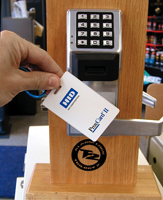
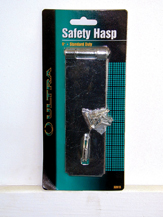
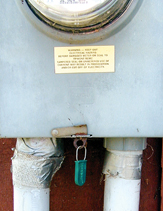
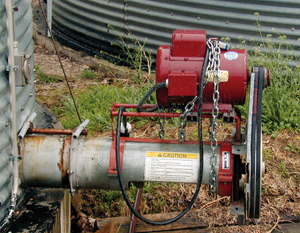
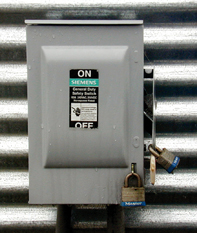
Physical Security Measures
Physical security measures are taken to protect your assets and to discourage intruders from entering your buildings. They include protecting doors, windows, fences, gates, etc., to prevent or delay an adversary's access to your property. Suggested physical security measures include the following. (Note: Measures pertaining to locks are discussed under "Physical Protection Procedures.")
- Lock your well cap and protect the well with secure fencing; and if you have an alarm system, be sure to install an anti-tamper device on the well cap. Plants, bushes, etc., can be used to conceal a well, but the effect is purely cosmetic; if the well is targeted, concealment provides no protection whatsoever.
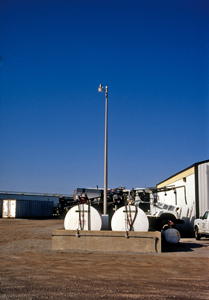
-
Install security lighting in key locations to deter trespassers (left). Cut vegetation away from buildings and fences to further enhance the effectiveness of lighting and to eliminate cover under which intruders might hide.
- Light critical assets such as fuel tanks, grain bins, and chemical storage areas to discourage intruders.
- Consider using glare (blind) lighting directed away from the asset that you are protecting and into the face of anyone trying to gain illegal entry. This causes intruders to be blinded, making it difficult for them to see who or what is in the vicinity of their targeted area-perhaps even causing them to abandon their intent.
- Exterior lights should be on motion sensors or controlled by photocells that turn them on and off according to the amount of natural light available. Manual activation and timers are less effective.
- Maintain clear zones along fences and other structures on property lines, eliminating obstructive vegetation. A distance of 15 feet is recommended.
- Install locked gates across lanes (bottom left) and driveways to prevent easy access to your home and buildings and to curtail non-farm traffic. Large rocks are useful in barricading trails made by unauthorized four-wheelers.
- Attention should be given to the hinged ends of farm gates to assure that the gates cannot be lifted off their hinges; the gates themselves should be constructed so that they cannot be disassembled by simply removing a few bolts.
- A driveway enunciator (e.g., the cable at the gas station that makes a sound when driven across) in critical areas can alert you when someone enters.
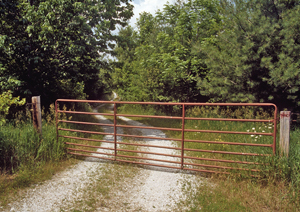
Electronic Security: Alarms, Access Control, Video Surveillance
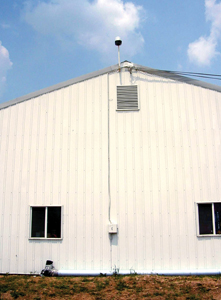
-
If recommended as a result of a credible security assessment, install electronic security devices to improve detection, delay, and response. Electronic systems and devices suitable for and applicable to farmsteads include the following:
- Switches activated by the opening of doors, gates, lids, etc.; motion sensors (right) that light an area when movement is detected; video recorders that are activated by motion; and electronic access controls such as card readers and electronic key/lock cores that release locks and record entry data relative to location, date/time, card holder, etc).
- Electronic card access controls, rather than keyed locks, should be used to restrict access where valuable assets are stored. They may not only control access but also record the date and time of entry; they may also record the specific card used to gain entry, thereby identifying the person whose card is used. Another important feature of electronic access is computerized control in selecting and assigning access levels and time zones when various cardholders' cards can be used.
- Video surveillance systems consist of cameras (below), monitors, and recorders. The most effective use of video is its integration with intrusion detection devices such as motion sensors. A motion sensor triggers an alarm and activates the video recorder in the area where the motion originates.
- Digital recordings are more efficient and effective than traditional audio tape recordings because 1) they record images as well as sound and 2) the tapes can be viewed selectively. The digital recorder is actually a computer that allows the farmer to retrieve and view video selectively by date and time of recording.
- Alarms can be monitored at the farm or at approved, off-site alarm monitoring stations.
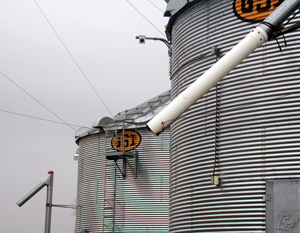 If the latter, monitoring station personnel would call the police, according to pre-established protocols, in response to alarm signals received from the farm. In addition to signaling a monitoring station and perhaps your computer, an activated alarm might trigger lights and sirens and/or place an automatic call to your cell phone.
If the latter, monitoring station personnel would call the police, according to pre-established protocols, in response to alarm signals received from the farm. In addition to signaling a monitoring station and perhaps your computer, an activated alarm might trigger lights and sirens and/or place an automatic call to your cell phone. - Thread aboveground phone lines through a conduit to prevent access. Purchase a cell phone for backup in case your landline service is interrupted.
Protection of Anhydrous Ammonia
and Other Chemical Tanks
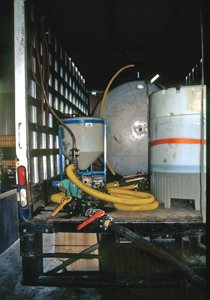
- Store anhydrous ammonia tanks in secure areas, only, where they can be seen easily: preferably in a well-lit, secure area. If that isn't possible, park the tanks at the rear of the field rather than along the roadside. Do not park them close to homes or livestock.
- Remove hoses from anhydrous tanks when not in use.
- Install high-security locks on anhydrous ammonia tanks and valves.
- Do not store ammonium nitrate in bags: they are easily stolen and the ammonium nitrate can be used to fuel homemade bombs.
- Have on file a list of agricultural outlet employees who are authorized to pick up your pesticides and fertilizers. Be sure that they have photo identification.
- Secure mini-bulk tanks left in the field (below).
- Disable large equipment by removing critical parts; e.g., anhydrous transfer hoses from nurse tanks.
- Secure bulk chemical tanks with locks at main openings, and lock the sight gauge.
- Provide secondary recovery dikes for bulk tanks in case there is a break in the primary container.
